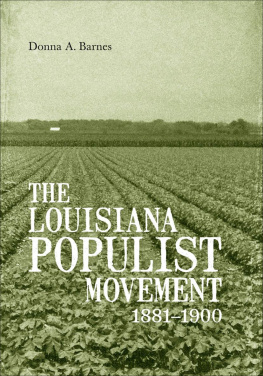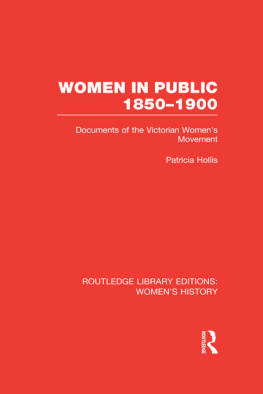Published by Louisiana State University Press
Copyright 2011 by Louisiana State University Press
All rights reserved
Manufactured in the United States of America
First printing
DESIGNER : Michelle A. Neustrom
TYPEFACE : Minion Pro, text; Berthold Baskerville Book, display
TYPESETTER : Thomson Digital, Inc.
PRINTER : McNaughton & Gunn, Inc.
BINDER : Dekker Bookbinding
LIBRARY OF CONGRESS CATALOGING-IN-PUBLICATION DATA
Barnes, Donna A., 1954
The Louisiana populist movement, 1881-1900 / Donna A. Barnes.
p. cm.
Includes bibliographical references and index.
ISBN 978-0-8071-3727-7 (cloth : alk. paper)
1. LouisianaPolitics and government18651950. 2. PopulismLouisianaHistory19th century. 3. Social movementsLouisianaHistory19th century. 4. LouisianaSocial conditions19th century. I. Title.
F375.B27 2011
976.305dc22
2010029104
The paper in this book meets the guidelines for permanence and durability of the Committee on Production Guidelines for Book Longevity of the Council on Library Resources.

Preface and Acknowledgments
WHAT CONDITIONS ARE FAVORABLE to the emergence and growth of social movements? This has been one of the central questions posed by social scientists interested in social movements. This book tackles this broad question by exploring the dynamics of the Louisiana Populist movement during the late 1800s. The Louisiana Populist movement was part of the broader southern Populist movement, which was essentially an agrarian revolt by small farmers. In its early years this revolt consisted primarily of self-help, economic strategies developed and implemented by a newly formed organization known as the Farmers Alliance. By 1892, however, the Alliance had shifted its focus to politics. The Alliance served in many southern states as a bridge organization to a newly established third party, the Peoples Party. Once formed, the Peoples Party largely displaced the Alliance as the primary vehicle for collective protest.
There were several factors that drew my attention to the southern Populist movement. First, this movement was one of the largest social movements in American history. In the South, the Farmers Alliance had approximately three million members at its peak in 1891. In many southern states, this membership became the major recruiting pool for the Peoples Party and helped make it one of the largest third-party challenges in American political history. Another factor drawing my attention to this movement was my interest in the responses of small farmers to the transformation of southern agriculture in the postCivil War era. This era was typified by the increased commercialization of agriculture, as well as the revolutionary shift away from a slave-based labor system in the production of cotton. The final factor influencing my interest was my concern about the temporal bias that currently exists in the field of social movements. Case studies have been strongly tilted in favor of contemporary movements of the postWorld War II era. If we are to better understand the factors conditioning the emergence and growth of social movements, we need to move beyond studying movements in the same time period.
Readers might be curious as to why I chose to focus on the Populist movement in Louisiana. To a certain extent, it was a pragmatic decision. The primary historical materials available to researchers of the southern Populist movement can quickly become overwhelming. Dozens of Populist newspapers are available in various state archives, as well as numerous daily and weekly newspapers with articles and editorials about the Populist movement. The research process is made all the more challenging by the fact that the Populist movement varied significantly from state to state. It is not a movement that lends itself easily to broad generalizations.
The primary reason, however, that I chose to focus on Louisiana Populism goes back to the early 1980s, when I was doing research for a book on late nineteenth-century agrarian protest in Texas. I discovered that while agrarian protest among small farmers in Texas was growing and its organizational manifestation, the Farmers Alliance, was thriving during the late 1880s, the protest movement among small farmers in the adjacent state of Louisiana was relatively anemic. It struggled to spread beyond a limited number of parishes in the northern and central part of the state. While the Alliance had recruited close to 50 percent of farmers in Texas, in Louisiana the rate was half of thatabout 25 percent of farmers. Furthermore, the Alliance-affiliated organization in Louisiana, the Louisiana Farmers Union, served as a weak bridge to the Peoples Party, the final organizational manifestation of the agrarian revolt.
The lackluster agrarian protest in Louisiana was puzzling to me because census data clearly showed that the states agricultural sector had levels of distress comparable to those in Texas. It was all the more puzzling because the Louisiana Farmers Union merged with the vibrant Farmers Alliance in Texas in 1887, prior to the explosive growth of the latter organization. Why had the protest movement among small farmers in Louisiana fared relatively poorly?
While social scientists have tended to focus upon the emergence and growth of successful social movement organizations, much can be learned from studying mobilization efforts that fail, or at least have very limited success. The relatively poor mobilization record of the Louisiana Farmers Union provided an excellent opportunity to explore factors impeding successful mobilization.
Other research endeavors, however, interrupted my intentions to pursue this research opportunity. More than a decade later, I belatedly returned to my interest in the challenges that undercut the efforts to build a successful Populist movement in Louisiana. My interest was further piqued by discovering that little had been written on Louisiana Populism. The last extensive treatment of the Populist movement in Louisiana was in William Hairs book, Bourbonism and Agrarian Protest, published four decades ago.
The objectives of this study of the Louisiana Populist movement are twofold. The first objective is to contribute to the historical understanding of the southern Populist movement by shedding light on its struggles to mobilize small farmers in Louisiana into a force for change. On a number of important points, the conclusions of my study differ from those of other studies of the Populist movement. Hopefully, my different interpretation of key aspects of the movement will invite discussion and, thereby, contribute to the ongoing scholarly debate about nineteenth-century Populism. The second objective is theoretical: to reflect on the Populist movement in Louisiana using social movement theories and to demonstrate the advantages of utilizing all three of the leading theories, rather than depicting them as competing theories or selectively employing one or the other of the theories. Too often, social movements are explored through discrete studies of shifting political opportunity, mobilization challenges, or framing issues. While such studies certainly have their value, what is missing is an examination of the dynamic relationships among these important factors. Such relationships, it will be shown, were important to both the development and the demise of the Populist movement. Furthermore, the theoretical objectives of the current study include an attempt to demonstrate that the leading social movement perspectives can be expanded in ways that address some of the major criticisms that have been leveled against these perspectives.








